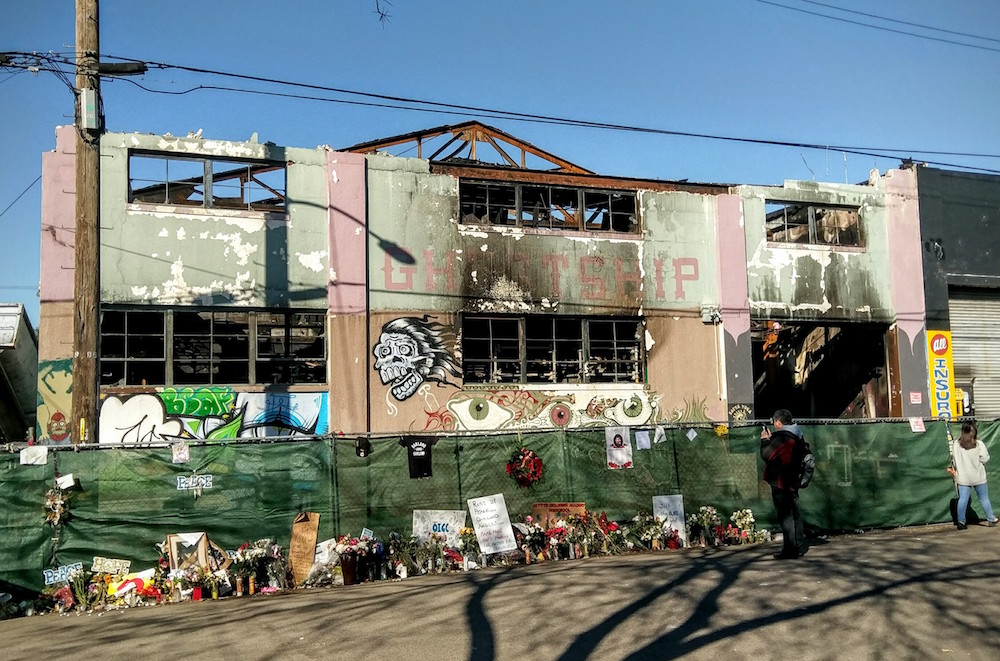An Oakland fire battalion chief said on Thursday that the chance of surviving the fire at the Ghost Ship warehouse in 2016 that claimed 36 lives was “very low” based on the amount of fire he saw coming from the structure when he arrived at the scene.
Battalion Chief James Bowron, who’s been a firefighter for more than 25 years, said the fire during a music party at the warehouse at 1309 31st Ave. after 11 p.m. on Dec. 2, 2016, “was like nothing I’ve seen before due to the fuel-loading inside the building.”
Bowron was referring to campers, RVs, artwork, tapestries, rugs, statues, and dozens of pianos and organs that filled the building, which master tenant Derick Almena said was an artists’ collective.
Bowron, who took command of firefighting efforts when he arrived at the scene a few minutes after the blaze was reported, said the people who died “were suspended in the worst possible place in a fire,” which he said in this case was the warehouse’s second floor, where the party was being held. He said the best way to escape a fire is to get to the first floor, stay low to the ground and crawl out but the blaze doubled in size every second, the smoke became intense and rose up and “there was no safe space on that second floor.”
Bowron also said, “It was not a true second floor” in that it was like an improvised mezzanine and wasn’t sealed, which made it unsafe to put ladders up to that part of the building. Bowron’s testimony came at the end of the third week of the trial for Almena, 49, and Ghost Ship creative director Max Harris, 29, who each face 36 counts of involuntary manslaughter, one for each person who died in the fire.
Prosecutors allege that Almena and Harris are criminally liable for the fire because there was no time and no way for the people at the party to escape since the warehouse didn’t have important safeguards, such as fire extinguishers, smoke alarms and exit signs.
Prosecutors also say Almena and Harris violated the terms of the warehouse’s lease by turning it into a living space where up to 25 people stayed and hosting underground music parties there.
But defense attorneys for Almena and Harris allege that the fire was an act of arson that Harris and Almena couldn’t have prevented. Defense lawyers second-guessed Bowron’s firefighting tactics on Thursday, just as they second-guessed those of Battalion Chief Heather Mozdean when she testified on Wednesday.
Harris’ lawyer Curtis Briggs said he thought, “A firefighter would run into a burning building and pull someone out” and alleged that Bowron prioritized saving firefighters’ lives over the lives of the 36 people who perished. But Bowron said that’s not true.
“We put service over self and take risks on a daily basis. They (Oakland firefighters) did everything they could that night.”
Oakland Battalion Chief James Bowron
Bowron said that when the fire flared up about 22 minutes after 12 firefighters entered the warehouse, which went dark after the electricity went out, “I thought they possibly could have died due to the conditions” because the roof was ready to collapse.
Almena’s lawyer Tony Serra asked Bowron if the fire is “a terrible blight on your reputation” and alleged that the reason Bowron is defending his department’s tactics is that it is being sued by the victims’ families. But Bowron said, “That’s not why I’m here,
“I’m here to tell what happened and give jurors the facts about what happened that night.”
Oakland Battalion Chief James Bowron
Earlier on Thursday, two Oakland police officers testified that Almena told them that no one lived at the warehouse when they visited the site before the fire. Officer Jonathan Low said when he responded to a call at the warehouse on Jan. 31, 2015, he asked Almena if anyone lived there and Almena said no one did. Former officer Tye Kushner, who is now retired, said when he went to the warehouse on Dec. 3, 2014, Almena also told him that no one lived there.
Testimony in the trial will resume on Monday.
